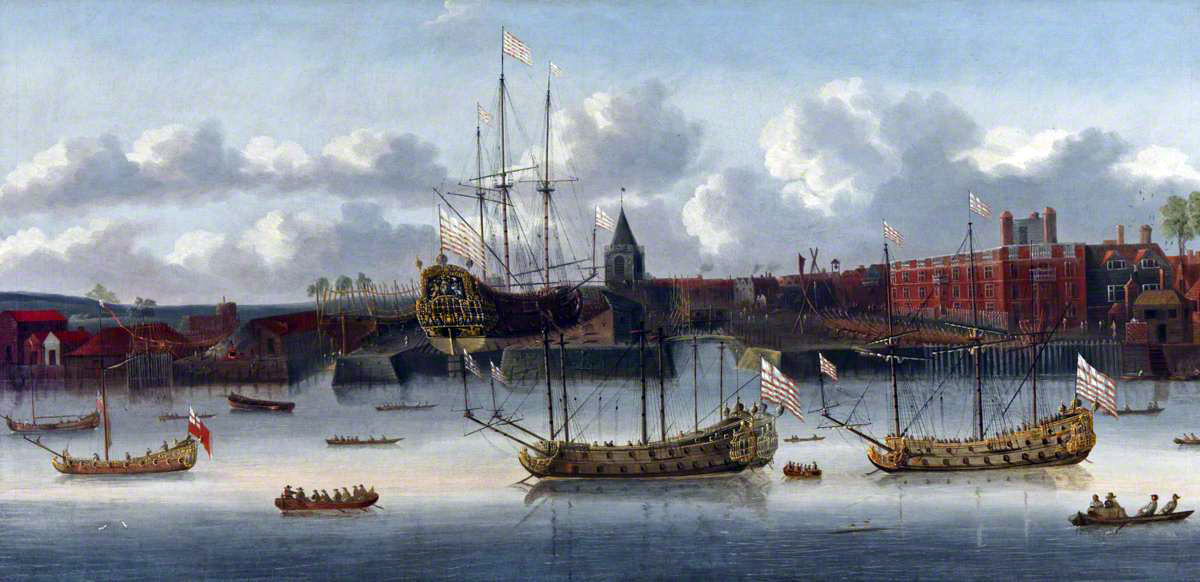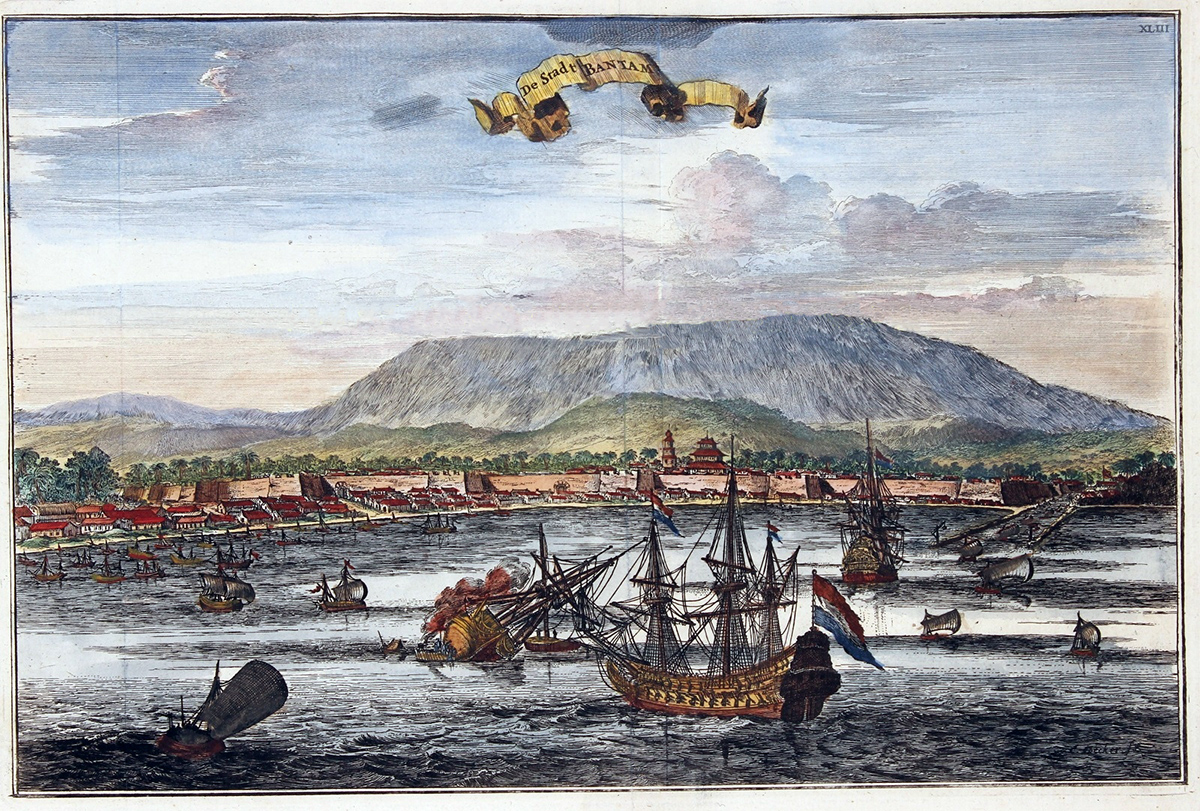Not Set
The huge English East Indiaman Palsgrave was wrecked on Drake's Island in November 1637.
Type
English East India Company armed merchant ship.
Location
Drake's Island in Plymouth Sound
History

Deptford Yard in 1660 with a large Indiaman on one of the two slips and two smaller vessels at anchor in the river (NMM)
The English East India Company was established in 1600 under a charter by Queen Elizabeth as a joint-stock association of English merchants trading to the 'Indies', as the eastern nations were known at that time. When the company was founded the cost of hiring large ships was high so from 1607 onwards the company built their own ships in Deptford (Wild, 1999). The first 20 years of the company’s life saw the building of some exceptionally large ships in the Blackwall and Deptford yards on the River Thames in London, thinking that bigger would be better (Davis, 2012):
Trade’s Increase, 1293 tons, built 1610
Palsgrave, 1083 tons, built 1617?
Royal Charles, or Charles, 1000 tons
Royal James, 1000 tons
These early ships were effectively warships at a time when the English were fighting the Dutch and Portuguese for supremacy in the East Indies, the ships were used to overawe local rulers and they needed to defend themselves against pirates. The Palsgrave left the Downs off Kent in 1619 on her first voyage heading for Surat in India, Batavia (Jakarta) in Indonesia, then Japan, and returning to England in 1623. Two other voyages were made to Bantam in 1624 and again in 1630. In 1632 the Palsgrave set off from London on her last voyage, this time to Bantam via the Persian Gulf and Surat under the command of Captain Richard Allnutt. In January 1635 the Palsgrave and Reformation left Bantam loaded with cargo. Towards the end of 1637, the Directors of the East India Company received news that two ships, the Palsgrave and Reformation had left Bantam and were nearing home. But Palsgrave’s voyage to London was to be her last, ending abruptly in Plymouth after making her way safely all the way from the East Indies. On board the ship she carried 307 tons of pepper, 113 tons of cloves, two tons of shells, nearly 5 tons of sugar and 193 bales of textiles and silk, a cargo worth at least £100,000.
The details of the loss of the Palsgrave are sparse but we can estimate the course of events. On 16th November the Palsgrave was moored in Plymouth Sound, probably in the Cattewater. The weather was not favourable, but Captain Allnutt decided to leave the safety of Plymouth and head to London as the Company Directors were waiting for the arrival of the ship and her valuable cargo. In the subsequent enquiry, the stories differ between the Captain who said that the weather was sufficiently good to leave port but suddenly grew violent. In the testimony of the surgeon, Richard Robinson, he maintained that the Pilot, the Purser Thomas Reynolds, and an employee of the Company called Thomas Monmouth all asked the Captain not to sail but to return to her moorings. Ships captains rarely welcome entreaties from the officers and the scene on deck can be imagined from the description: ‘The defendant (Allnutt) being in a fretful mood and passionate humour, threw downe his staffe and stamping said, that he would not returne.’
Piecing together the fragments of the story it seems that the ship tried to return to port but could not, this was a huge ship and like the Trade’s Increase, she would have been hard to handle even in good weather, never mind in a storm. The vessel anchored inside the Sound using a single anchor; her head swung round to face the weather and the sea started smashing violently on her bows. The crew put their faith in God and prayed for salvation while the ship’s carpenters busied themselves blocking up the anchor hawse pipes to stop the raging sea coming in and flooding the deck. Hands were called to pump ship and to bale water from the gun deck. The single anchor failed to hold the huge ship against the wind and the ship then started to drag backwards towards Drake’s Island. The Pilot advised the captain to drop another anchor but by this time the ship was three and a half fathoms of water (6m) which was too shallow for the anchor to be effective. In these circumstances, it was usual to cut down the masts to reduce windage and relieve some of the pressure on the anchor cable but again the Captain refused, stating in the tribunal that ‘part of the mast would have been on land and part on the ship, and its weight, with the rolling of the sea, would have split the vessel’, which was unlikely. Eventually, the cable securing the single anchor broke, and the ship was driven ashore. Despite all the poor decisions, Allnutt still refused to take any blame and instead said the wreck was due to ‘the imediate hand of God’. The Court of Committees for the Company didn’t put any faith in the Captain’s defence of his actions and instead decided to proceed against him in the Court of Admiralty.
When the bad weather cleared the huge ship was found on the rocks of Drake’s Island in shallow water. The ship then became the responsibility of the Agents for the East India Company and the Governor of Plymouth Fort and St. Nicholas Isle, Sir James Bagge II. The ship may not have been directly Bagge’s responsibility, but he knew what was on board so saw an opportunity, and with his son-in-law, Sir Nicholas Slanning, started to organise the salvage of goods and material from the ship. Bagge was a man with a reputation for being an extremely corrupt local tyrant who was constantly manoeuvring situations to his advantage, gaining him the nickname of ‘Bottomless Bagge’ in 1628. But out of the vast cargo, very little was saved, just 70 bags of pepper out of the 307 tons on board, some cloves and 100 bales of silk. Slanning also salvaged the guns and some calico cloth which the Company agreed to sell to him, with Slanning paying half the cost of their recovery. So much loss of cargo suggests that the huge ship quickly broke up and scattered its contents on the shallow foreshore. Only a small quantity of the 113 tons of cloves was saved and it is not recorded what happened to the rest of the pepper, but it was probably scattered then spoiled by seawater, while the sugar would quickly dissolve when it got wet. The timbers from the ship would have been salvaged and reused, with the broken fragments being used for firewood. Some of the iron fittings from the ship, round shot ammunition for the guns and smaller items may not have been recovered. The value of the £100,000 cargo after the wrecking was calculated to be just £5,000, without the costs of the salvage being deducted. It is not recorded what Bagge got paid, but he did not live much longer to enjoy it as by June 1638 he was seriously ill and by August he was dead.
The Company did learn from this mistake. They sent letters to the trading posts in India and Indonesia telling them what happened to the Palsgrave and telling them to send back ships to Europe ‘more seasonably’ so they do not arrive in wintertime.
This ship is sometimes called the 'Paulsgrove' which is incorrect.
Digest version, for more information please contact The SHIPS Project.
Location and Access
The location of this wreck is unknown, other than being somewhere on Drake's Island.
Permission to dive around Drake's Island must be obtained from King’s Harbour Master, Plymouth.
Last updated 04 May 2023
Information
Type:
Armed merchantman
Date Built:
1617?
Date of Loss:
16 November 1637
Manner of Loss:
Wrecked
Outcome
Salvaged
Builder:
English East India Company
Official Number:
None
Length
Unknown
Beam
Unknown
Depth in Hold
Unknown
Construction
Timber
Propulsion
Sail
Tonnage
1083 tons
Nationality
English
Armament
42 guns
Crew
Unknown
Master
Captain Richard Allnutt
Owner
English East India Company
Reference
Hob UID: 876212
.
Not Set
Leave a message
Your email address will not be published.
Click the images for a larger version
Image use policy
Our images can be used under a CC attribution non-commercial licence (unless stated otherwise).



![Drake's Island in Plymouth Sound [The SHIPS Project]](../images/Wrecks/SHIPS_Drakes_1200.jpg)